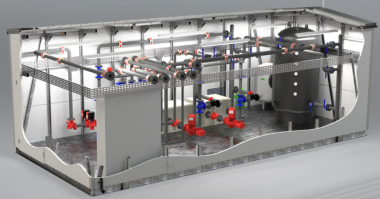Authors: Kurt Gokbudak, Systems Architect, Schneider Electric, and Jack Creamer, Market Segment Manager, Pumping Equipment–Industry Business, Schneider Electric
An Integrated Building Management System (IBMS) is one of the most critical future-proofing tools a building owner can employ – as it helps them achieve many of the aforementioned strategies. For instance, an IBMS solution helps reduce risk in a facility by identifying where critical maintenance and repair is needed, where energy savings potential exists, and where it’s wise to invest in retrofitting versus new construction.
An IBMS can also collect tremendous amounts of data from throughout a facility as it monitors, measures, and continuously optimizes energy consumption. This helps to isolate and alleviate inefficiencies like unused space, or aging pumping, heating, cooling, and air systems, reducing energy costs and operations budgets. In addition, an IBMS that utilizes open protocols is adaptable to future technological upgrades. Existing systems can be updated quickly to accommodate changing technology and future advancements, ensuring that aging buildings are equipped with the latest and most powerful innovations throughout their entire life-cycle.
There is another plus for energy management on school campuses and in hotels and office buildings. For instance, energy management and sustainability initiatives have a strong appeal to incoming students, and, in fact, these kinds of programs can actually help recruit students. This is also becoming a key influencer for hotel guests and office building tenants as well. In addition, for the managers/owners of these facilities, energy demand is rarely 24/7. So, programs can optimize energy consumption around occupancy. A good example focused on pumping is swimming pool management. As pools are generally opened between designated hours, it has been demonstrated that energy savings can be recognized in less than a year with such programs.
What does a connected, smart facility look like?
As building owners and managers future-proof their facilities, they have unprecedented opportunities to add intelligent innovation that will build a smart foundation and integrated infrastructure for years to come. These kinds of steps will more fully ensure that facilities are truly aligned with an organization’s goals and policies on space management and capital allocation.
Here are a few recommended steps to help building owners and managers embark on the journey of creating a smart, connected, and efficient facility:
Build a team of stakeholders and identify needs. Make a list of influencers, decision-makers, and system users from building facilities, sustainability, IT, management, and key tenant organizations, as well as architects, designers, and engineers. Identify the needs and requirements each group may have and invite them to participate when the appropriate aspect of the process requires their expertise and support. A strong buy-in from all parties is critical.
Understand the modernization requirements and respective needs. Perform a complete evaluation of the building’s systems and how they are used. Collect any available data on space utilization, energy management, building management, and technology that can support the decision-making process. Correlate the evaluation and existing data with the costs of operation and maintenance to determine the most pressing, at-risk facilities and systems. Utilize industry benchmarking tools to accelerate this process.
Develop a 5-10 year plan of action. Determine what critical actions must be addressed immediately, and address other less pressing ones by pro-actively scheduling them over the course of a multi-year period. Others could be moved farther out as part of a preventive, rather than a reactive, action plan.
Determine priorities. Delineate the objectives, priorities, and other pertinent criteria for a future-proofing plan that is appropriate.
Set capital improvement priorities. As part of a longer-term plan, prioritize where CapEx and OpEx budget funds will be most effective.
Conduct educational workshops. Make all stakeholders aware of the future-proofing efforts and how they can contribute and support them.
Evaluate and invite experts that can help. Find experienced vendors that can help building owners monitor, measure, and manage systems across an entire facility or campus of buildings. These vendors provide integrated facilities management and control, with an integrated infrastructure that connects mechanical, electrical, IT and communications technology, and security systems.
Create a request for proposal. As potential partners are identified, create a short list of qualifying vendors and develop a request for proposal.
Choose the best solution. In reviewing requests for proposals, determine which solution providers can best meet the requirements of the recommended strategies delineated here.
READ PART 3: TURNING AN AGING FACILITY INTO A SMART ONE.
Use Cases
Organizations around the world are undertaking massive efforts to make their facilities smarter. Here are a few examples:
The Edge is in Zuidas, Europe’s fastest growing business and knowledge district in Amsterdam, The Netherlands. This complex is the world’s most sustainable office building as it received BREEAM-NL outstanding rating, with a 98.36% rating, the highest ever given. It also has been called “perhaps the most fully realized vision of the IoT the world has ever seen.1
The Edge not only sets a new global benchmark for the built environment, but also prioritizes the comfort, health, and productivity of its occupants. Real-time energy consumption and efficiency data gathered from its BMS are shared with building occupants and visitors via a dashboard located on a video screen located in the building’s lobby. The building uses less than 0.3 kWh/m2 per year energy consumption and actually produces approximately 102% of its own energy.
The Davis School District in Utah is a leader in energy efficiency among K-12 schools The district recently completed the transition to energy efficient solution in over 90 facilities encompassing over 10 million square feet, including 59 elementary schools, 16 junior high schools, eight high schools, and three alternative high schools. The school now has one integrated system with updated, cutting edge technology to ensure their facilities are operating at peak energy efficiency. The district reduced energy consumption by 7% and improved learning environments while campus square footage grew 18%. The district received the 2013 Excellence in Energy Award in the category of Responsible Energy Development from the state of Utah.
John G. Shedd Aquarium in Chicago, IL, a facility built in 1930, recently leveraged existing building management system, sensors, and meters to push data points to a building analytics solution. The solution automatically pinpointed root cause of problems and identified energy cost-avoidance opportunities daily, while prioritizing recommendations and suggested actions. It also assigns dollar value to energy opportunities and tracks and validates energy project metrics. For its 480,817 sq. ft. buildings, the facility saved $8,363 energy cost avoidance in first two months the solution was in place.
Hilton Worldwide in Washington, DC, wanted to enhance the guest experience while improving resource efficiency. Leveraging data synthesized by a resource advisor solution, Hilton lowered its energy costs and improved its guest experience across its global portfolio of owned, managed, and leased properties. Automated bill management minimizes late fees and utility pricing discrepancies, while innovative building management solutions reduces energy expenditures. Its guest room management systems improved guest satisfaction. The company has realized 14.5% in energy savings since 2009.
The University of North Texas in Denton, TX, gained a 31% reduction in energy costs, equal to $14 million in savings, over the course of two energy savings performance contracts. As one of Texas’ largest universities, the 105-year-old university has 54 buildings in its 12 colleges and schools. To achieve its goal of a “climate neutral” campus, the school underwent a series of renovations and energy upgrades, which included retrofits to the learning environment and direct digital controls for improved comfort. The school also put in variable frequency drives for better air flows, improved lighting systems, and other equipment and systems upgrades.
Boston Scientific in Marlborough, MA, has achieved an annual cost savings of approximately $30,000 – $40,000 with an integrated building analytics solution for its five building campus. During the first year of operation, a total electric savings of 160,184 kWh was realized, and an additional 137,200 kWh in the second year, which is the equivalent of carbon sequestered by 5,257 tree seedlings grown for 10 years or removing 43.2 cars from the road. The company also secured a $33,264 performance incentive from its energy company as a reward for enhanced energy efficiency throughout the campus. In addition, this project has also resulted in a 40% reduction in avoidable cost related to faults, including a 51% reduction in energy-related faults as well as a 49%reduction in faults causing improper zone conditions. The engineering team continues to gain valuable insights from the system and anticipates realizing additional cost savings through future energy reduction measures.
Conclusion
Building owners and managers have a critical need to develop an innovative infrastructure to ensure that all facilities meet the needs of today and the future.
Such investments will create cost efficiencies and increase the quality of life for office tenants, hotel guests, and students on campus. And it will increase the ease of maintenance for facilities managers, while increasing profit for building owners.
Other resources that may be of value in this journey toward future-proofing facilities:
- Build an integrated hotel solution.
http://www.schneider-electric.us/en/download/document/998-19795924/
- The benefits of a guest management solution.
http://www.schneider-electric.us/en/download/document/BR-HO-GUESTROOMMGT-A4/
- Create a sustainable, high-performance university campus.
http://se-enable.com/wp-content/uploads/Create-a-sustainable-high-performance-university-campus.pdf
- Predictive Maintenance Strategy for Building Operations: A Better Approach:
http://www.schneider-electric.us/documents/buildings/wp-predictive-maintenance.pdf
Footnotes
1 The Smartest Building in the World: Inside the connected future of architecture, by Tom Randall, September, 2015.
About the Authors
Kurt Gokbudak is a systems architect for Schneider Electric. He focuses on understanding the energy and operational challenges and needs that facilities face today so Schneider Electric can provide the best tools to address them and better position these facilities for the future. He has been with Schneider Electric for 5 years and has held sales, marketing, and operational positions throughout his 25-year career. He is a Certified Energy Manager (CEM) and is an active member of the Association of Engineers (AEE) and the American Society of Heating, Refrigerating, and Air-Conditioning Engineers (ASHRAE). He holds a bachelor’s degree in mechanical engineering from the University of Illinois.
Jack Creamer is Schneider Electric Segment Marketing Manager – Pumping Equipment, based in the United States. Mr. Creamer has more than 30 years in the Electrical Industry, and has been involved for 10 years in the Pumping Industry. He is involved in key industry organizations such as the Hydraulic Institute and Submersible Wastewater Pump Association, where he holds both Committee Chair and Board level positions. In his time in the Pump industry, he has help Schneider create numerous solutions that both enhance pumping efficiency and address issues such as maintenance and downtime.





Comments